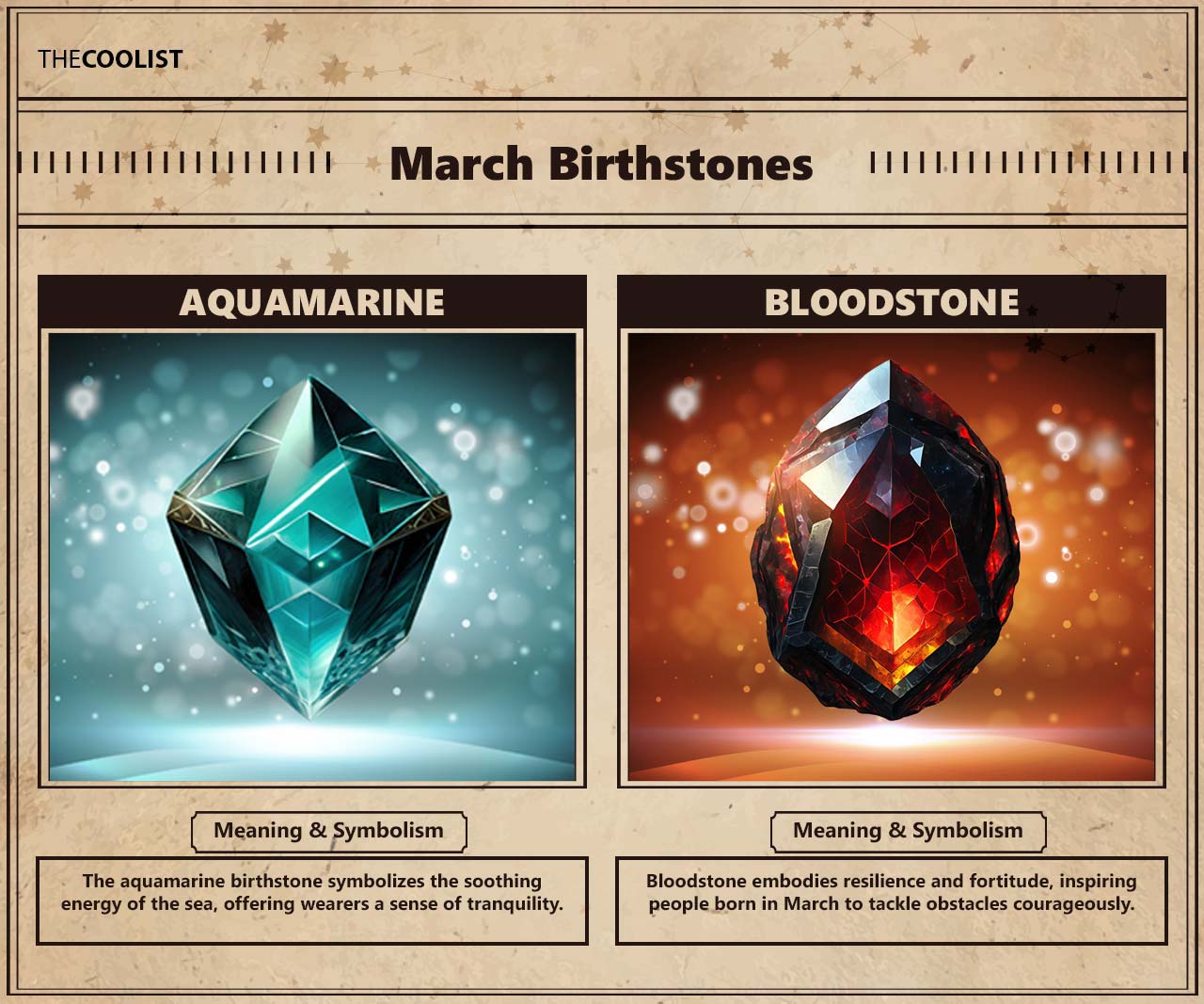The March birthstone options are aquamarine and bloodstone, symbolizing clarity and courage. The March aquamarine birthstone is famous for its pale blue to greenish blue coloring, while bloodstone boasts a dark green surface with red inclusions. People born in March benefit from the variety of birthstone styles available and can mix and match to create unique looks and receive positive energy from the stones.

Aquamarine’s name hails from the Latin “aqua” for water and “mare” for sea, reflecting its spectrum of blue tones, representing emotional clarity and tranquility. Historically, aquamarine has been a beacon of safety for sailors and a symbol of enduring love, chosen for engagement rings to represent steadfast commitment.
Bloodstone, or heliotrope, presents a striking contrast with its dark green matrix accented by red spots, akin to droplets of blood, enhancing its association with fortitude and healing. Bloodstone has been esteemed since antiquity for its purported abilities to purify and invigorate, supporting the lymphatic system and circulation, thus promoting physical vitality and resilience. The Jewelers of America’s 1912 standardization heralded aquamarine as the modern embodiment of March, yet bloodstone remains the traditional gemstone, offering a legacy of health and protection.
This dual offering for March allows individuals to embrace the gemstone that aligns with their essence, whether drawn to aquamarine’s reflective calmness and lucidity or bloodstone’s robust vitality and protective strength.
Below, we explore each March birthstone’s significance, history, and benefits.
What does the March birthstone mean?
The two official birthstone options for March are aquamarine and bloodstone, representing clarity and courage, respectively. The first March birthstone is aquamarine, symbolizing communication, protection, and clarity. Aquamarine is connected to the throat chakra, the center of communication and self-expression, facilitating spiritual growth and awareness. For example, The Complete Guide to Crystal Chakra Healing by Philip Permutt explains aquamarine’s connection to clear communication through the throat chakra.
Furthermore, aquamarine derives its protective qualities from its historical use as a talisman, shielding travelers from harm. Finally, aquamarine garners its name from the Latin words “aqua” and “mare,” meaning “water” and “sea,” which evokes the gem’s oceanic color palette and channels clarity, calming and soothing its wearers.
Conversely, March’s second birthstone is a bloodstone, representing courage, dedication, and revitalization. Bloodstone is linked with the root chakra that promotes grounding and resilience to bolster one’s dedication to one’s pursuits. For example, in Laying on of Stones by Conway, D. J., she discusses how bloodstone’s vibrational energy fortifies the will and revitalizes the mind and body.
Moreover, the bloodstone’s dark green appearance with flecks of iron oxide red echoes its significance in courage, symbolizing the warrior’s strength and the vitality of lifeblood. The name “bloodstone” conjures images of vitality and fortitude, further enhancing its connection to the themes of rejuvenation and steadfastness, making it an emblem of perseverance for those born in the transitional month of March.
Aquamarine and bloodstone are hailed for their mystical healing energies and protective qualities. Aquamarine is famed for its soothing sea-blue essence, which calms the mind and encourages spiritual communication, mirroring the bloodstone’s capacity to fortify and invigorate the spirit. Both stones are celebrated for their connection to the chakras, with aquamarine to the throat chakra for truth and clarity and bloodstone to the root chakra for courage and renewal. March birthstones are united in their power to guard against negative influences and offer a harmonious blend of peace and resilience, serving as spiritual guardians for those seeking balance and transformation.

Is there a difference between modern and traditional March birthstones?
Yes, there is a difference between modern and traditional March birthstones due to variations in cultural traditions and marketing factors. Bloodstone was the traditional birthstone associated with March. Historical records dating back to 1870 state that bloodstone is the gem for March, connecting through strength, encouragement, and fortitude. The Jewelers of America made bloodstone an official March birthstone in 1912. However, aquamarine was added alongside bloodstone on the 1912 list due to its marketability.
What are the alternate birthstones for March?
Three alternate birthstones for March are bloodstone, ruby, and jade. The first alternate birthstone for March is bloodstone, a traditional option often outshined by aquamarine. Bloodstone is a green variety of chalcedony with specks or streaks of red resembling blood drops. This gemstone embodies protection, strength, and healing, endorsing courage and vitality.
The second alternate birthstone is the guardian angel stone, ruby. While not traditionally linked to March, Ruby is sometimes chosen for its vibrant red hue that symbolizes love and passion. It is believed to bring energy and vitality, aligning with the dynamic end of the winter season. The third March birthstone alternative is the Tibetan birthstone, jade. Jade is a green gemstone valued in many cultures for its beauty and symbolism. Jade conveys harmony, balance, and good fortune. For example, jade symbolizes wisdom and is carved into jewelry and figurines in Chinese culture.
Is there a March zodiac birthstone?
Yes, there are two main March zodiac birthstone choices based on the Pisces and Aries signs. The first March zodiac birthstone is aquamarine, which is associated with Pisces. Pisces signs are known for their empathetic and intuitive nature, which aligns with the serenity and compassion that aquamarine is believed to bring. The second zodiac birthstone is a diamond for Aries. The diamond symbolizes strength and invincibility, complementing Aries’ energetic and pioneering spirit. While aquamarine represents tranquil and healing energies connecting to the Pisces sign, diamonds offer strength and resilience for Aries-born individuals. This selection allows March-born people to choose a gemstone that resonates with their zodiacal attributes and the qualities they wish to enhance or celebrate.
What color is the March birthstone?
The March birthstone aquamarine is a blue or blue-green color. The name “aquamarine” is derived from the Latin words “aqua” and “mare,” meaning water and sea, respectively. Aquamarine gemstones vary in shades from pale, almost transparent blue to deeper, more intense blue-green tones. The color of Aquamarine is one of its most defining and desirable characteristics, making it a popular choice for jewelry.
March’s second birthstone bloodstone is dark green with red or brown spots. These red markings are called “blood” spots, which give the stone its distinctive name. The combination of dark green and red or brown specks in Bloodstone creates a visually striking and unique appearance, resembling drops of blood on a green surface. Hence, this coloration is a key characteristic of Bloodstone.
What is the March birthstone crystal shape?
The following four formations showcase the crystal shape of each March birthstone.
- Pegmatite: Pegmatite is a coarse-grained igneous rock composed of interlocking crystals formed in the final stages of magma crystallization. Pegmatite crystals and gems can be large because the slow cooling allows for significant growth.
- Schists: Schists are a metamorphic rock characterized by thin, parallel layers and often contain elongated minerals. Schist gemstones may be flattened or stretched in shape due to the intense pressure that realigns the mineral grains.
- Druzy: Druzy is a coating of fine crystals on a rock fracture surface, vein, or within a geode. Gemstones and crystals in druzy formations have a glittering, sparkly appearance and are composed of many small, interconnected crystals creating a textured surface.
- Gneiss: Gneiss is a high-grade metamorphic rock known for its banded appearance due to mineral segregation. Crystals in gneiss may be irregularly shaped, often reflecting the alternating bands or lenses within the host rock’s structure.
Aquamarine and bloodstone are found within the above formations, influencing the shape the stone grows in. Despite both March birthstones appearing in similar formations, their crystalline structure differs. The aquamarine birthstone features a hexagonal crystal system because of the beryl composition that consists of interconnected rings of beryllium, aluminum, and oxygen atoms. Moreover, various trace elements, especially iron, give Aquamarine its blue or blue-green color.
Conversely, bloodstone is a microcrystalline form of quartz known for its dense and opaque characteristics, composed of minuscule, tightly packed quartz crystals. This gemstone is part of the trigonal crystal system, a feature common to all quartz varieties. It is distinguished by its dark green color with red speckles caused by iron oxide impurities, giving it a unique, blood-speckled appearance.
What’s the history of the March birthstone?
The history of the March birthstones, aquamarine, and bloodstones extends back to antiquity. Ancient Greeks used aquamarine stones to inscribe artful designs known as intaglios, a popular decorative piece of art in ancient Greece. In ancient Greece and Rome, aquamarine was a popular piece of jewelry because the stone promoted overall vitality and emotional well-being. For example, Symbols of Magic: Amulets and Talismans by Clifford Lindsey Alderman explains that Romans wore the aquamarine stone to protect themselves against throat, jaw, liver, and stomach problems.
Following a similar history, bloodstones were found in ancient Greece and named “sun-turning” because the stone turned blood red at sunset. However, according to Christian belief, the first bloodstone was formed when Christ’s blood fell to the foot of the cross. The cross was placed upon jasper, which then transformed into the bloodstone. Other cultures utilized bloodstone for its revitalizing properties. For example, warriors in Rome and India would use a powdered form of bloodstone to prevent hemorrhaging after a wound in battle.
Famous examples of the March birthstones have appeared throughout history, with prominent figures possessing the stones. For example, Rudolf II had a seal etched onto a bloodstone during the Holy Roman Empire, which now resides in the Louvre. Then, in the 1900s, Brazilian President Getúlio Vargas gave US First Lady Eleanor Roosevelt one of the largest aquamarine crystals in the world.
The American National Retail Jewelers created a standardized list of birthstones in 1912, certifying aquamarine and bloodstone as the official birthstone for March. The list aids consumers in identifying their birth month gemstones and preserves each stone’s historical and metaphysical significance. Aquamarine is embraced as the modern emblem for March, reflecting the tranquil and rejuvenating energies of the transitioning seasons. It’s frequently sought after for its blue hues and calming influence, symbolizing serenity and clear communication. However, bloodstone retains its valorous and robust essence, offering an anchor of steadfastness and healing. Each stone continues to be cherished for its deep-rooted symbolism and as personal talismans for those born in March.
Where is the March birthstone found?
The March birthstone options are found in North and South America, Africa, and Asia. North and South America are the first prominent regions to find a March birthstone. For example, the Brazilian state of Minas Gerais is renowned for its aquamarine deposits. Additionally, bloodstone is found in Brazil, and deposits have spread through the United States and into the Canadian province of Nova Scotia. The second area producing each March birthstone is Africa. For example, aquamarine is found throughout Africa in Zambia, Tanzania, and Mozambique, producing vivid blue colors.
Off the coast of Africa, Madagascar is known for delivering aquamarine renowned for its clarity and blue-green hues. Madagascar offers more March birthstone options, with the island being host to bloodstone deposits known for a rich display of red inclusions. Asia is the third region where each March birthstone is found. Afghanistan has a long history of mining gem-quality aquamarine. For example, the Panjshir Valley is one of the country’s well-known areas for aquamarine extraction. However, prominent bloodstone mining occurs in Southeast Asian countries like India.
March birthstone chart
Below is a chart explaining the core aspects of March birthstones.
| March birthstones | |
| Modern | Aquamarine and bloodstone |
| Traditional | Bloodstone and jasper |
| Zodiac | Aquamarine (Pisces) and diamond (Aries) |
| Meaning | Clarity and courage |
| Color | Blue-green and dark green with red inclusions |
| Historical significance | Used for protection and courage |
What are the March birthstone personality traits?
Five distinguishable personality traits are associated with the March birthstone combination of aquamarine and bloodstone.
- Calm and serene: People born in March are calm and composed, much like the serene waters associated with Aquamarine, while bloodstones have a soothing presence that delivers peace to those around them.
- Clear thinkers: Aquamarines improve mental clarity and communication. Similarly, March-born individuals are clear thinkers and know how to make sense of complex situations and express themselves effectively.
- Empathetic and supportive: Bloodstone and aquamarine stabilize and improve your mood, which parallels the empathetic and supportive nature of people born in March.
- Good communicators: Aquamarine’s connection to the throat chakra and communication means that March-born individuals are effective and compassionate communicators. They convey their thoughts and feelings with clarity and concision, reminiscent of the third month’s connection to numerology practices.
- Courageous: March-born individuals are brave and willing to face challenges head-on. Aquamarine gives you the inner strength to navigate life’s ups and downs, while wearing bloodstones boosts your courage.
Are there benefits to wearing a March birthstone?
There are five benefits to wearing a March birthstone: emotional balance, communication, clarity, protection, and empathy. The first benefit of wearing a March birthstone is aquamarine, helping maintain inner harmony and emotional balance. This gemstone will calm the mind, reduce stress, and promote inner peace, especially during emotional turbulence. The second benefit of a March birthstone is effective communication. Wearing Aquamarine enhances communication skills and facilitates clear and honest expression. Hence, this march gemstone is excellent for individuals who want to improve their ability to convey their thoughts and feelings.
The third benefit of wearing a March birthstone is mental clarity. Aquamarine’s connection to mental clarity helps with decision-making and problem-solving. Those who frequently wear aquamarine report having greater focus and analytical thinking, potentially leading to better decision-making. The fourth benefit of a March birthstone is that Aquamarine was used as a protective amulet for sailors. Wearing Aquamarine evokes a sense of protection during long-haul trips or in life’s unpredictable journeys. The final benefit of wearing a March birthstone is that aquamarine fosters empathy and compassion. Wearing this gemstone encourages feelings of understanding and support for others, creating more harmonious relationships.
Should you wear aquamarine or bloodstone for your March birthstone?
Yes, you should wear aquamarine and bloodstones if you’re born in March to amplify the traits associated with the gemstones. March-born individuals absorb the most energy from both gemstones because they resonate most with their vibrations. Aquamarine is a great gemstone choice if you seek to improve your inner peace, wisdom, and discernment.
Conversely, bloodstones are more suitable to enhance your courage, strength, and fortitude. Remember, there is no hard and fast rule regarding who can wear certain gemstones; the March birthstones are no exception. Whether you’re born in March or drawn to bloodstone or aquamarine, you’re energetically compelled and compatible with that gemstone.
What are the different ways you can wear your March Birthstone?
There are four ways to wear your March birthstone of aquamarine or bloodstone: rings, necklaces, earrings, and bracelets. The first way to wear aquamarine or bloodstone is set as a classic choice in the center of rings. March gemstone rings come in various designs, from simple bands to more intricate and decorative styles. The second way to wear March birthstones is in necklaces, which showcase the cut and clarity of the aquamarine and bloodstone. March birthstone necklaces come in different chain lengths and styles to suit your taste.
The third way to wear March’s bloodstone or aquamarine is with earrings because they add a touch of elegance and refinement to your appearance. The fourth way to wear the March birthstones is in a bracelet, which is easy to remove and showcases a larger surface area for gemstones. Birthstone bracelets are highly versatile because the gemstone can be worn as a single gemstone or within a collection of stones. Ultimately, you can wear the March birthstone in multiple ways to create dazzling and eye-catching ensembles.
Can you wear a bloodstone and aquamarine every day?
Yes, you can wear bloodstones and aquamarines every day. You’re encouraged to do so because they will ensure you receive a consistent flow of the energies in the gemstone. The more times you wear bloodstone or aquamarine, the stronger the effect the stone has on your vibration. Hence, you’re more likely to reap the benefits of both stones if you wear them daily.
| Further reading on birthstones | |||||||||||
| January | February | April | May | June | July | August | September | October | November | December | |

